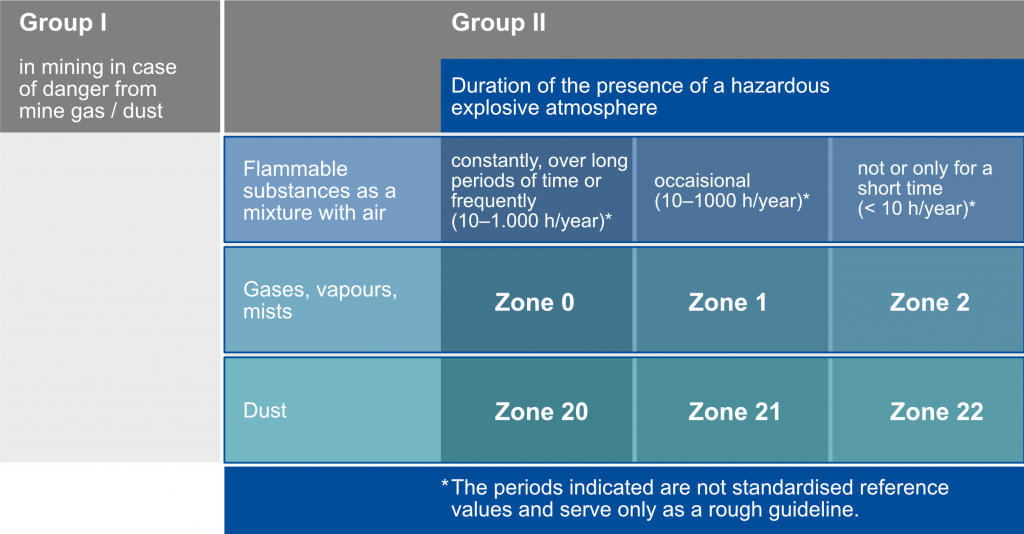Legal situation
ATEX 114 (RL2014/34/EU)
This directive is only valid for manufacturers and has the objective of ensuring the free movement of products subject to the directive within the EU. For this reason, the directive establishes harmonised requirements and procedures for demonstrating compliance.
After 30 June 2003, products can only be placed on the market and/or put into service within the EU if they complied with Directive 94/9/EC. As of 20.04.2016, Directive 94/9/EC has been replaced by Directive 2014/34/EU.
It should be noted that Directive 94/9/EC as well as Directive 2014/34/EU lay down essential health and safety requirements, namely
for electrical and non-electrical equipment intended for use in explosive gas atmospheres, and
for electrical and non-electrical equipment intended for use in potentially explosive dust atmospheres, and
for protective systems and devices intended for use outside potentially explosive atmospheres and required for the safe functioning of equipment and protective systems in relation to explosion risks.
In the area of explosion protection for industrial trucks, the appointed named bodies have issued a large number of “regulations”. The most important directives are 2014/34/EU (until 19.04.2016 RL94/9/EG) for manufacturers and 1999/92/EG for operators. These directives are addressed to manufacturers and operators of equipment and protective systems intended for use in potentially explosive atmospheres.
This results in the following basic requirements for manufacturers according to RL2014/34/EU:
QS / ATEX – Certification: The manufacturer must demonstrate a certified QS system according to ISO 9001:2015 in his company. This system must be additionally certified according to ATEX by a named body with regard to the production of Ex components or equipment (Directive 2014/34/EU, Article 12/13/14).
Developments of industrial trucks according to EN 1755, 2000 (Industrial trucks “Use in potentially explosive atmospheres”).
CE Declaration of Conformity according to Directive 2014/34/EU, Annex X.
CE marking, according to Directive 2014/34/EU, Article 15 and Article 30 of Regulation 765/2008 as well as Annex II of Regulation 765/2008
Product liability for the entire unit (normal and Ex).
Spare parts supply for the entire unit (normal and Ex).
Service for the entire unit (normal and Ex).
Documentation for the complete device (normal and Ex) (deposited with a named body, e.g. PTB, INERIS, CESI) or alternatively EU type examination certificate for the complete device.
Directive 2014/34/EU has been transposed into national German law by the 11th Ordinance to the Product Safety Act (Explosion Protection Products Ordinance – 11.ProdSV).
ATEX 134 (Directive 1999/92/EG)
This directive only addresses operators. Higher requirements may be imposed by individual EU states in national implementations.
Directive 1999/92/EC: Explosive Atmospheres establishes the minimum requirements for improving the safety and health protection of workers potentially at risk from explosive atmospheres.
Directive 1999/92/EC applies to the protection of workers employed in potentially explosive atmospheres.
In Germany, implementation took place within the framework of the BetrSichV with regard to work equipment on 03.10.2002 and “systems requiring monitoring” (e.g. explosion-protected fork lift trucks) on 01.01.2003. National implementation can be regulated beyond the requirements of the minimum regulations.
The employer must fulfil his obligations and prepare an explosion protection document in accordance with §6 of the Ordinance on Hazardous Substances (formerly §6 of the Ordinance on Industrial Safety and Health) and keep it up to date. The transitional period for drawing up an explosion protection document expired on 31.05.2005.
PTB Publications
Articles on the subject of “Industrial trucks for use in potentially explosive atmospheres” can be found here:
• Responsibility of the operators during commissioning, repair and periodic inspectionmore…
• Placing on the market according to Directive 94/9/EC and EN 1755 (new RL/2014/34/EU) more…
MIAG Fahrzeugbau GmbH
Kocherstraße 1
38120 Braunschweig
Germany
Fon +49 531 8 66 01 0
Fax +49 531 8 66 01 50
info@miag.de

designwork © www.2ax.net

